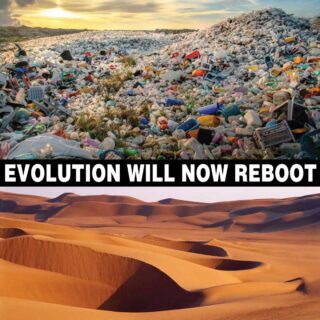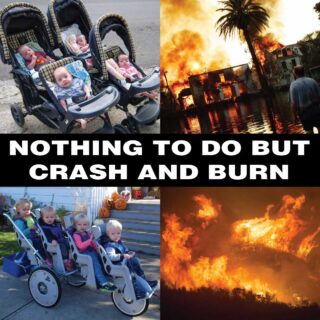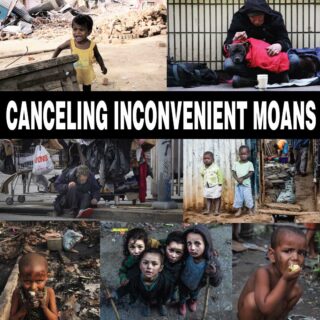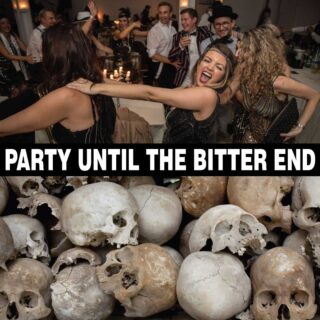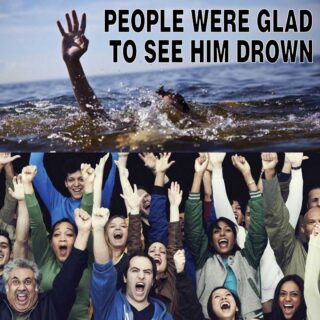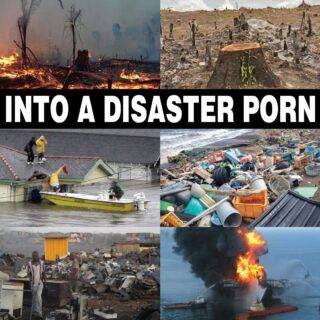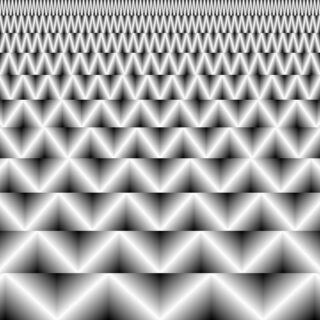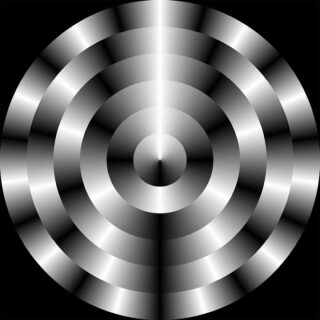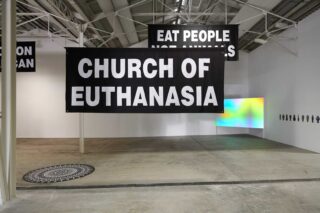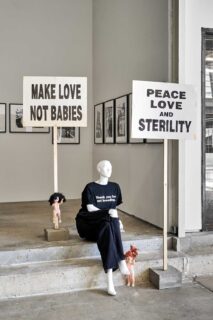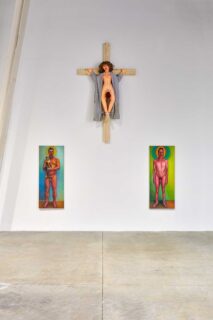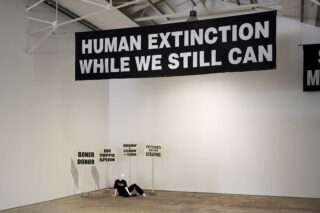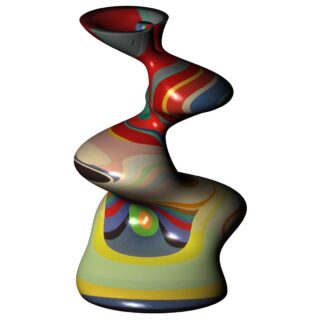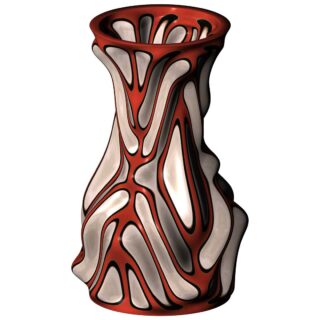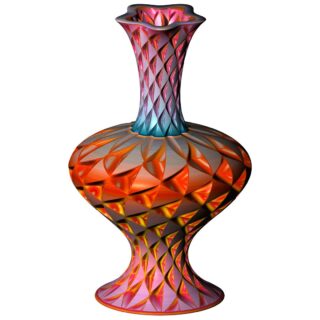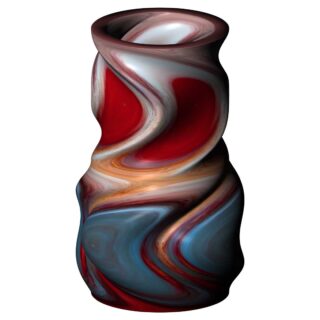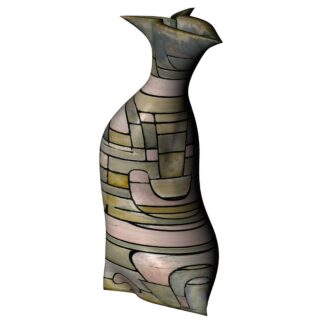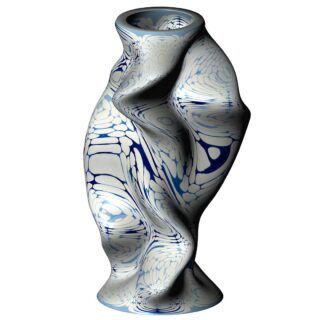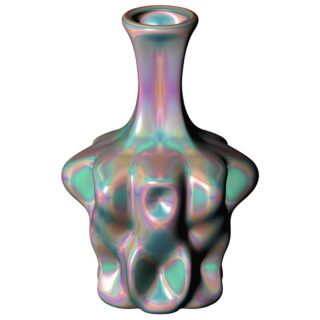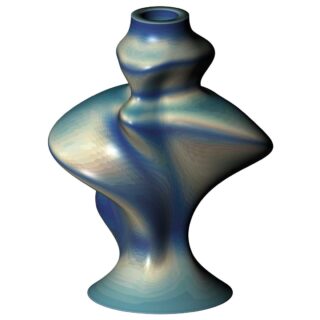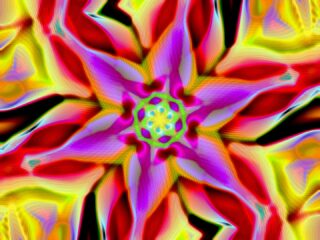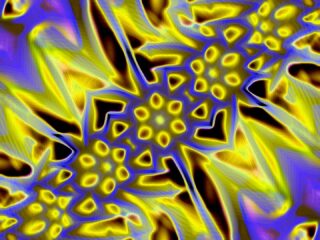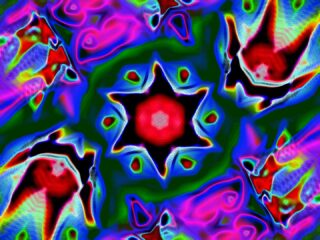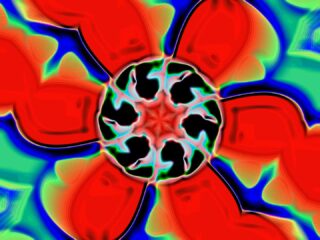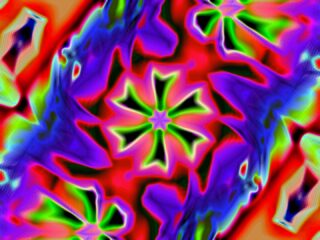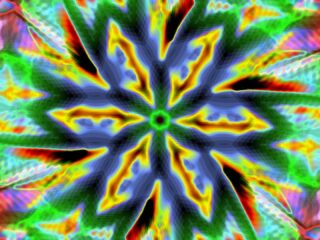This conversation is not only about the Church of Euthanasia — even though Korda’s radical antinatalist movement from the 90s seems to be more urgent than ever. It is about us, about our future, and our home planet Earth.
It is also about Chris’ current retrospective “The (Wo)man of the Future” at Le Confort Moderne curated by Goswell Road showing her many facets from being a transgendered suicide cult leader to composing electronic music, creating digital art, and developing free software for the last 30 years.
It’s an intimate talk between Reverend Chris Korda and Cardinal.e Jardin, the newest member to the Church of Euthanasia in Europe. A chat between two artists, one that is making her very own waves since decades and the other — a young French musician — who is riding those waves in their very own way today. Jardin, “one of the few people left who sincerely intend to change the world” — as i-D labelled them — is asking the right questions. And Chris’ is giving essential answers. Oui futur!
IN CONVERSATION: JARDIN AND CHRIS KORDA
PHOTOGRAPHY: PIERRE ANTOINE

‘I contain multitudes.’
Jardin: My lovely Reverend, I’m so glad to join you for the opening of your first retrospective “The (Wo)man of the Future” at Le Confort Moderne (Poitiers, France) curated by Goswell Road. It will be another opportunity for me — after your first show at Goswell Road — to see the original materials you produced for our Church of Euthanasia as a late-European-comer. I guess it will be intense for me. What’s your relation with those objects? Can you describe to me and our readers what’s your personal background to those artefacts?
Chris Korda: It might be helpful if I can approximately describe the conflicting impulses I feel before I actually write anything, because not all of my impulses are constructive, and I want to represent the show in a positive way that the curators Anthony and Coralie will approve of. It’s tempting to talk only about the Church of Euthanasia because of what’s happening in the USA, and more globally, with abortion and other regressions to the Dark Ages, but the show is only about half Church of Euthanasia, or even less perhaps. It may seem incoherent to people, because it is. I am not one thing. People have tried to portray me as a monoculture, to claim that I begin and end with the Church, but it’s not true. I contain multitudes.
‘But meanwhile climate change is accelerating horribly, it’s obvious that humanity is completely unable to control itself, and so all of my work sits under the shadow of extinction.’
I understand why people want to focus on the Church. It’s extremely topical, more so even than it was thirty years ago. But during those same thirty years, I had whole other careers — software development, VJ-ing, digital art, phase art, virtual art, photography and signal processing — that had nothing to do with the Church. Above all, during those years I developed as a composer of music, to the point where now increasingly I make music that sounds nothing like the music I was making in 1995. I taught myself atonality, and adopted classical instrumentation, and these are huge changes. But meanwhile climate change is accelerating horribly, it’s obvious that humanity is completely unable to control itself, and so all of my work sits under the shadow of extinction. It’s depressing and confusing. And on top of that, over these thirty years, my work has been consistently suppressed, embargoed, censored, and de-platformed by mainstream media, denying it the access and reputation that it certainly deserves.
Above all I think it’s necessary to talk about tragedy, and how it’s handled in this show, because I suspect many people will be puzzled to discover that much of my work is joyful, even exuberant. I strongly disagree with Adorno’s famous quip that “after Auschwitz, to write a poem is barbaric.” On the contrary, as I experience the Species Holocaust, I feel it is my sacred duty to bear witness to it in poetry, song, art, and every other media, and to do so with humour and empathy; to communicate not only the bitter irony of our predicament, but also the nobility of our ambitions, and the heartbreaking tragedy of our collective failure to achieve them.
‘The urge to extract value from horror is a crucial link between the Dadaists and The Church of Euthanasia.’
How to relate art to the experience of inconceivable horror? With the stinking mud from the trenches still fresh in their memories, the Dadaists struggled with this question. How to move beyond merely regurgitating personal traumas, and transmute them into something constructive and inspirational of lasting value? The urge to extract value from horror is a crucial link between the Dadaists and the Church of Euthanasia.

It’s always a pleasure to talk to you and see how you transcend the ambient darkness. That’s why I identify myself to your work. I felt the same when I discovered your song “I Like To Watch” (2003) for the first time, you always manipulate important themes, with a huge portion of poetry, humour, sensitivity and serious gravity. I think I’ve always been concerned by your multiplicity, maybe because of our non-binarity, but I think mostly because it’s not acceptable to simplify the world. The digital era is the realm of simplification. What do you as a coder think about that? First time we talked for ID France I told you that I saw many links between the Church of Euthanasia and your record “Akoko Ajeji” (2019). What are the links with your newest record “Passion for Numbers” (2022)?
‘Binary digits are aggregated into numbers, and such numbers can represent literally anything.’
I don’t identify the digital era with simplification, on the contrary I identify it with an exponential increase of expressive potential. Confusion often arises because of the supremacy of binary. The fact that a binary digit is limited to only two values, zero or one, frightens non-technical people because it seems to eliminate ambiguity. But if you think more carefully, you’ll realize that a binary digit is almost never encountered by itself. Binary digits are aggregated into numbers, and such numbers can represent literally anything. Digital quantities are the essential foundation of a rapidly growing family of representational systems which are theoretically capable of any amount of gradation. Decimation (the assigning of numbers to quantities) is an astoundingly successful technique for faithful reproduction of sense stimuli. For example, high resolution digital audio formats have already reached a degree of fidelity beyond which further improvements will be undetectable by human ears. Photography too is now better served by pixels than silver molecules. Film is still holding its own against video, but not for much longer. Criticizing digital media for its binariness is like criticizing literature for its use of black ink on white paper. Content should be judged not by its encoding scheme, but by the ideas that it communicates.
‘Criticizing digital media for its binariness is like criticizing literature for its use of black ink on white paper.’
My fascination with machines and their expressive potential can be traced to some of my earliest experiences. As a child I demonstrated an instinctive affinity for machines, for example I often repaired the family toaster merely by touching it. I devoured technical explanations precociously, and spent countless days happily exploring science museums with my mother’s encouragement. DuPont, IBM, and similar conglomerates had huge showrooms in New York City which often featured dazzling demonstrations of new technologies. I vividly remember my teletype chat with ELIZA, an early software emulation of a psychiatrist. The 1970s were also a fruitful period for kinetic sculpture, and I was certainly influenced by the works of Alexander Calder and Jean Tinguely. But most importantly, The Museum of Modern Art had one of Thomas Wilfred’s “Lumia” machines in its collection, and this was undoubtedly the first explicitly phase-based kinetic art I ever encountered. At the age of thirteen I built a large motorized kinetic sculpture in the studio of one of my father’s acquaintances, but regrettably it was lost.
‘I enjoy collaborating with machines because they have skills that I don’t have, and vice versa.’
My passion for numbers didn’t blossom until I discovered computer science in college. It became immediately obvious that I had an extremely unusual aptitude for computer programming. At my teacher’s request, I stopped attending class and instead worked independently on special projects. Soon after that I began a thirty-five year career in software development. Much of my art could never have existed without the engineering skills I learned from my profession. I enjoy collaborating with machines because they have skills that I don’t have, and vice versa. They supply speed, precision, thoroughness, and repeatability, whereas I supply intention, emotion, instinct, and whimsy.
I would like to see robots dancing to my polymeter music. They are much better suited to expressing complex phase relationships than human beings ever could be. Perhaps I could get a grant from Boston Dynamics for polymeter robot dancing. Assuming industrial civilization continues for a significant time, I expect robots to dominate dance and athletics, just as they already dominate in strategy games. Thus far robot choreography has been relatively cliched and anthropomorphic, but I see it progressing towards a radically new art form. Engineers often have conventional tastes and try to please an average human audience for marketing reasons, but such aesthetic shortcomings could disappear quickly as the technologies become more widely accessible.
Reading you, I need to be precise that I’m not technophobic. Even after publishing the video to “Départ” on 2nd of June showing a sculpture from my friend Agir Bizarrement. It will be the second excerpt from “Exode,” my upcoming EP-shortfilm directed by Selim Bentounes. Here I translate the lyrics for you:
START
I leave all this behind
My prison, my apartment
Where I take the hundred steps
I don’t feel it
I leave all this behind
I’m going to pass the mountains
All these cheap dreams
I don’t want it
…
I take the train for nowhere
Years that we talk about it
To an island in the Mediterranean
Blue Ocean White Pyrenees
Our stories from another world
Where the other is by our side
I will bring the dream to life
With my thousand-year-old friends
I have nothing better to tell
All these years to break the chains
Now that the concrete has collapsed
For the horizon, for all these plains
Yes you know the air is less poisoned
Culture of magician
Vibrates calmly on the sound system
Cyberpunks with dogs, wind turbines
Autonomy for bitches & hyenas
…
I leave all this behind
My prison, my apartment
Where I take the hundred steps
I don’t feel it
I leave all this behind
I’m going to pass the mountains
All these cheap dreams
I don’t want it
…
It will never feel victory
It stinks of joy, it stinks of hope
We put the benefit aside
A few years of hold-ups
In our bags we have two three rifles
We’ll do what we want with this fucking life
The disease may well take me
I fuck borders in the middle of December
I want to suffer more anything
Nothing to fuck to flee to Mars
I want to stay with my bratz
Sometimes get high to the breed
Eyes on the valley
Watching Humanity Fly Away
To all the children I will meet
I have nothing better to tell
…
I leave all this behind
My prison, my apartment
Where I take the hundred steps
I don’t feel it
I leave all this behind
I’m going to pass the mountains
All these cheap dreams
I don’t want it
[Jardin, Départ — translation]
I’m not technophobic but humanity has a certain taste to hijack technologies to a sad purpose, over-exploitation, artificialization of soils, greedy centralisation. I certainly prefer Boston Dynamics’ dogs dancing to your polymeter sequencer. May I ask you to explain the relation of the large scale vision you designed in “Akoko Ajeji” and the apocalyptic-human-centered narrative which is now the justification for any trans-humanist excess — like sucking the Earth’s blood till we probably never reach an exoplanet? As you already said: “One World One Shit.” Still at the end, are you an optimistic person?
I may sound optimistic, but beneath that I’m a pragmatist, a realist, and an existentialist. We’re obliged to play the ball from where it is, not from where we’d like it to be. I don’t feel imprisoned, I have no desire to escape, and even if I did there’s nowhere to escape to. Intact nature no longer exists, and I’m untroubled because I don’t romanticise nature. Earth is altered by human thought and will become more so. We’re marooned here for the foreseeable future, because outside of Earth’s protective atmosphere, hard radiation would kill us rapidly. Colonisation of exoplanets is wishful thinking. People consistently underestimate the lethality of space.
‘Refusal to procreate is a potent symbol of limits to growth.’
As Church of Euthanasia members, we agree to nothing more or less than non-procreation, and why? Surely not because it’s an effective population reduction strategy. Since the Church was founded in 1992, the human population has increased by a third. We take a lifetime vow of non-procreation for its symbolic value. Refusal to procreate is a potent symbol of limits to growth. By sacrificing our reproductive potential, and refusing to contribute our DNA to the future, we turn our personal lives into examples of living within limits. We broadcast to the world that human beings are not necessarily helpless victims of their bestial drives, that we can behave rationally and cooperate constructively to achieve a more enlightened future.
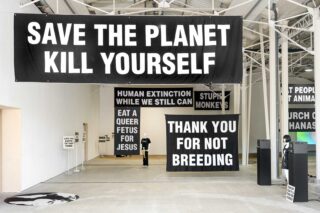
[installation view of “The (Wo)man of the Future. Chris Korda, une rétrospective” at Confort Moderne, curated by Goswell Road, 2022]
I don’t romanticize the past. For most of the few hundred thousand years that Homo Sapiens has existed, life was unimaginably brutal, a pointless parade of grotesque cruelty. The notion that all human beings are entitled to life, liberty, and the pursuit of happiness is little more than 200 years old, an eye blink of geological time. For most of human history, there were no rights. If you were born male, your life revolved around flattering the local warlord, and if you were born female, you were reproductive machinery, to be used like a copier until you broke. Social mobility was unheard of. Your fate was determined by the sperm and egg lottery, the biological crapshoot of your ancestry, and in many places that’s still true today, horribly.
‘For most of human history, there were no [human] rights.’
Women didn’t acquire the right to vote until the mid-19th century. Struggles against racism, sexism and homophobia occurred throughout my life. I witnessed dramatic victories for civil rights, female liberation, and LGBTQ+ rights, progress that was unthinkable in previous generations. Like me, you are a beneficiary of this progress. More than that, you had a front row seat at the banquet of life. I know this from the way you speak and write and conduct yourself. For all of its faults, industrial civilization lavished us with literacy, numeracy, and countless other benefits. Let us not take these precious gifts for granted. It’s understandable that you’re tempted to hide from the challenges posed by modernity, but by hiding, you do the future a disservice. As beneficiaries of progress, we have a responsibility to give back, to share our advantages with the less fortunate, and this we do by using our creativity to illuminate the world.
‘From now on, we can only expand intellectually […] and inspire us to be the better angels of our nature.’
My projects are my children, and they bask in the love that would otherwise have been usurped by biological offspring. “Akoko Ajeji” is my blessed baby, bathed from birth in unconditional love. By redirecting my love away from biological destiny and towards art, I point the way for our future. We can no longer grow biologically. We have reached and vastly exceeded the ecological limits of Earth. From now on, we can only expand intellectually, and those of us with the necessary tools must rise to the occasion, and inspire us to be the better angels of our nature.
Those past months and years were and still are really intense for all of us. There’s no way to escape for sure. But I know that you are a prolific creative person. Are art, music, thoughts, coding, body experiences, and collective organisations ways to escape a really heavy and destabilising reality? This beautiful metaphor of us as nature’s angels sounds like an out-of-body experience and of course makes me think about the life which will keep going without us after human extinction. To me, art is a way to find and give meaning to a surprising, troubling, unjust, joyful, pleasant, exciting life. I’m not really interested in what will stay at the end. I only count the movement, the intensity, the ethics of the interconnections between the world and me, which is really hard to focus on. What’s your relation to your multiple practices, as Chris Korda — the (wo)man of the future?
‘To succeed in life, we must distinguish between what can and can’t be changed, and face the former bravely while humbly accepting the latter.’
I don’t want to escape from reality, because it’s the only viable foundation of truth. Philip K. Dick was right to call reality “that which, when you stop believing in it, doesn’t go away.” As Einstein quipped, the moon is really out there, even when you’re not looking at it, and to claim otherwise is childish solipsism. In the film “Platoon,” Sergeant Barnes expresses my deepest convictions when he says “I am reality,” and continues that “there’s the way it ought to be, and there’s the way it is.” To succeed in life, we must distinguish between what can and can’t be changed, and face the former bravely while humbly accepting the latter.
My favorite architect, Eero Saarinen, famously opined that “the purpose of architecture is to shelter and enhance man’s life on Earth and to fulfill his belief in the nobility of his existence.” And I feel similarly about my art. My task as an artist is to depict my inner world as faithfully as possible, by unflinchingly materializing the figments of my imagination. I’m not obliged to be pleasing, coherent, or even comprehensible; I’m only obliged to stay true to my vision. By transmuting the raw material of my subconscious mind into artifacts, I strive to inspire and create transcendent value.
‘We burn brightly because we can.’
Art is part of the story we’re telling ourselves about how we got here and what we should do about it. Art gives my life meaning, and connects me to the collective story of civilization, to our past and future. Meaning can only come from us, because as Clive Langham grimly reminds us in “Providence,” “out there in the icy universe, there’s nothing.” Despair is a wasteful, selfish response to the certainty of death. The ephemerality of existence is precisely the motive to use time wisely before we become what Black Elk so eerily called “grass on the hills.” We burn brightly because we can.
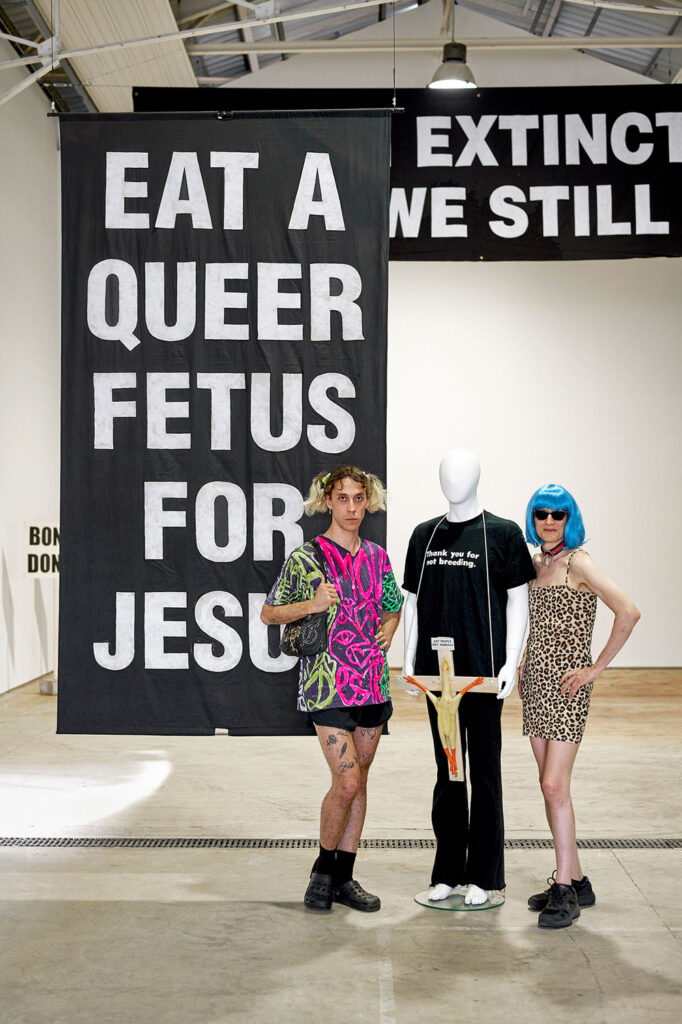
The retrospective “The Wo(Man) of the Future” runs until 28th August at Confort Moderne.
Chris Korda “Passion For Numbers” LP is out on Musique Pour La Danse, “More Than Four” will be released in September on Chapelle XIV.
Visitez:
The (Wo)man of the Future. Chris Korda, une rétrospective
Chris Korda
Jardin




